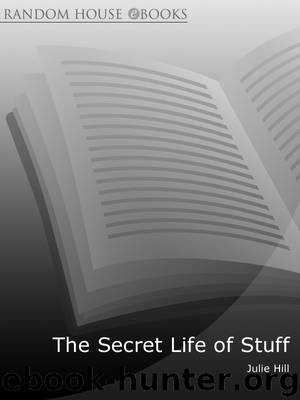The Secret Life of Stuff by Julie Hill

Author:Julie Hill
Language: eng
Format: epub
Publisher: Vintage
Part 5
Designing the Future
12
Where do products come from?
In Part 2, we deconstructed the things that make up our lives to think about their constituent materials, and their place in our current ‘linear economy’. In Part 3 we saw that we might hit environmental limits of different kinds. In Part 4, we saw how we have little option but to consume (although we have choices about how much) and also how today’s product choices offer little scope for even the most dedicated green consumer to lead a change away from the linear economy. Now we are going to look at how we might design things differently.
To get to the heart of what is needed, we have to think more creatively about how materials become products, and then become ‘waste’. We have to think about the whole chain of production and consumption in which they, and we, are embedded – where they come from, how we use them and where they end up. Before humans came along, materials sat around in the ground, or as animals and plants, or just as chemical compounds. All were blissfully unaware of their ‘usefulness’ – they just were. It was humans who created uses for them, and now we take most of those uses for granted.
In 2009, I was delighted to discover that in the bowels of King’s College London, there is a ‘materials library’ – the project of materials expert Dr Zoe Laughlin. Zoe’s mission is to put on display in the two small rooms allotted to her by the university as many materials as possible, and illustrate their potential. I had an entertaining hour looking at Zoe’s tuning forks made of various materials, from metals and woods to plastics and glass, and listening to their diverse ‘notes’. I felt the weight of different metals, each of them rendered in exact 2cm cubes, from the featherweight feel of aluminium to the astonishing density of tungsten. One cube was a single unusually large crystal of the mineral pyrite, often confused with gold.
But beyond these curiosities, what is the relevance to us of materials? Only really their use in products. So Zoe’s materials get even more interesting when she demonstrates that things taste better off a gold spoon rather than a silver one, or shows me the nickel ‘super alloy’ which is the only material strong enough to make jet engine turbine blades. Or demonstrates ‘silly putty’, a viscose elastic polymer (plastic to you and me), which is liquid enough to flow rather disconcertingly off the edge of the table if you leave it alone, but strong enough to resist knocks when used in protective sports gear and motorcycle jackets. I was also allowed to hold a magical blue cube of silicon-based ‘aerogel’, direct from the research labs of NASA. At 99.8% air, so only 0.2% ‘stuff’, it is the world’s lightest solid. Zoe explained that it was designed to catch the dust in comet tails for analysis (some of it has made a 3-billion-mile journey through
Download
This site does not store any files on its server. We only index and link to content provided by other sites. Please contact the content providers to delete copyright contents if any and email us, we'll remove relevant links or contents immediately.
The Lonely City by Olivia Laing(4768)
Animal Frequency by Melissa Alvarez(4424)
All Creatures Great and Small by James Herriot(4266)
Walking by Henry David Thoreau(3921)
Exit West by Mohsin Hamid(3791)
Origin Story: A Big History of Everything by David Christian(3665)
COSMOS by Carl Sagan(3584)
How to Read Water: Clues and Patterns from Puddles to the Sea (Natural Navigation) by Tristan Gooley(3430)
Hedgerow by John Wright(3313)
How to Read Nature by Tristan Gooley(3289)
The Inner Life of Animals by Peter Wohlleben(3282)
How to Do Nothing by Jenny Odell(3263)
Project Animal Farm: An Accidental Journey into the Secret World of Farming and the Truth About Our Food by Sonia Faruqi(3188)
Origin Story by David Christian(3169)
Water by Ian Miller(3153)
A Forest Journey by John Perlin(3042)
The Plant Messiah by Carlos Magdalena(2899)
A Wilder Time by William E. Glassley(2833)
Forests: A Very Short Introduction by Jaboury Ghazoul(2814)
